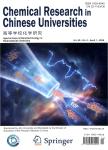First-Principle Studies on Adsorption of Cu^+ and Hydrated Cu^+ Cations on Clean Si(111) Surface
First-Principle Studies on Adsorption of Cu^+ and Hydrated Cu^+ Cations on Clean Si(111) Surface作者机构:School of Chemistry and Chemical Engineering School of Environmental Science and Engineering Shandong University Jinan 250100 P. R. China School of Chemistry and Chemical Engineering University of Jinan Jinan 250022 P. R. China
出 版 物:《Chemical Research in Chinese Universities》 (高等学校化学研究(英文版))
年 卷 期:2010年第26卷第3期
页 面:472-478页
核心收录:
学科分类:083002[工学-环境工程] 0830[工学-环境科学与工程(可授工学、理学、农学学位)] 081704[工学-应用化学] 07[理学] 070304[理学-物理化学(含∶化学物理)] 08[工学] 0817[工学-化学工程与技术] 0703[理学-化学]
基 金:Supported by the National Natural Science Foundation of China(No.20633060)
主 题:Silicon surface Copper Ion-solid interaction Adsorption Density functional calculation
摘 要:To study the adsorption behavior of Cu^+ in aqueous solution on semiconductor surface, the interactions of Cu^+ and hydrated Cu^+ cations with the clean Si(111) surface were investigated via hybrid density functional theory(B3LYP) and Moller-Plesset second-order perturbation(MP2) method. The clean Si(111) surface was described with cluster models(Si14H17, Si16H20 and Si22H21) and a four-silicon layer slab under periodic boundary conditions. Calculation results indicate that the bonding nature of adsorption of Cu^+ on Si surface can be viewed as partial covalent as well as ionic bonding. The binding energies between hydrated Cu^+ cations and Si(111) surface are large, suggesting a strong interaction between them. The coordination number of Cu^+(H2O)n on Si(111) surface was found to be 4. As the number of water molecules is larger than 5, water molecules form a hydrogen bond network. In aqueous solution, Cu^+ cations will safely attach to the clean Si(111) surface.



